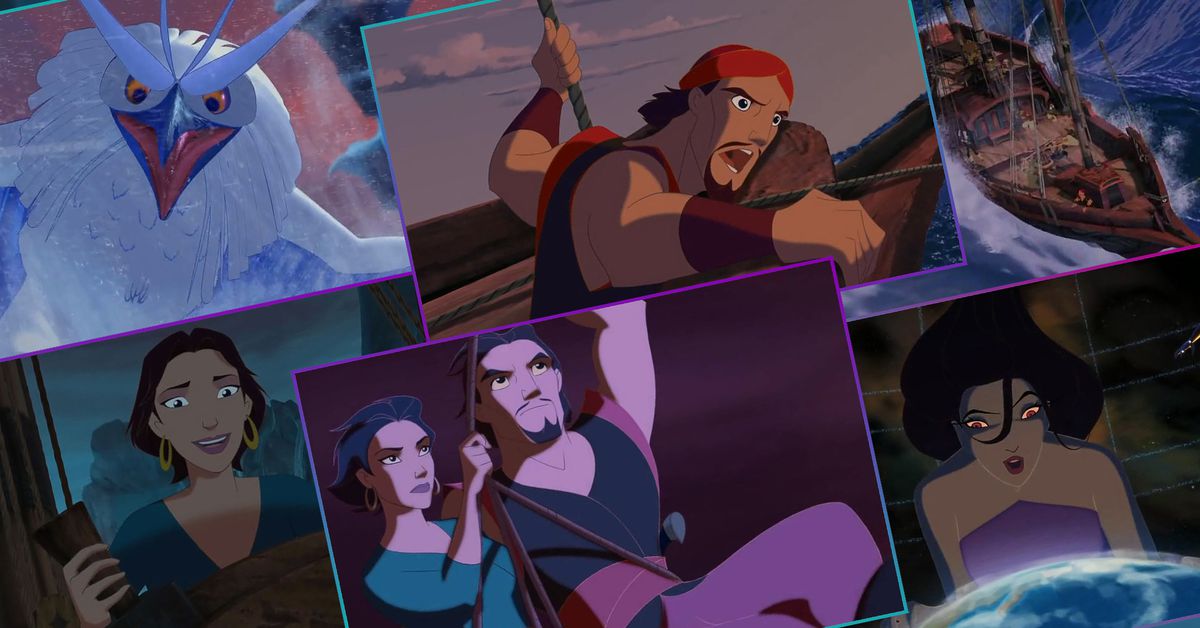
Unfortunately, it came out the same week as Pirates of the Caribbean
Your favorite childhood movie might’ve been a total box-office dud. The animated movies that defined the late ‘90s and early 2000s are beloved by a generation that grew up watching them on VHS, but many of these nostalgic favorites were critical failures, box-office disappointments, or both.
What went wrong along the way? And why did they gain such love after the fact? The Beloved Animated Failures series is out to dust off those old VHS tapes (or, more accurately, find the movies on streaming) and examine some of these films.
DreamWorks’ traditional animation department went out with a whimper in 2003 with the comparatively overlooked adventure film Sinbad: Legend of the Seven Seas. A more serious tale than the studio’s CG flicks, like Shrek and Antz, Sinbad flopped at the box office, suffering from general tonal disconnect and stemming from executive meddling: the creators saw it as a chance to tell a mature story, while executives at the top wanted to appeal to children and their families. But unlike the studio’s previous film, The Road to El Dorado, Sinbad didn’t even reach the epic internet highs of a cult favorite.
Perhaps the least beloved of the beloved animated failures of the post-Disney Renaissance, Sinbad isn’t so much a failure as it’s a forgotten film, swept under the rug as DreamWorks found its niche in comedic movies and CG animation. But the company’s last hidden gem is an exciting seafaring adventure with memorable character designs and relationship dynamics. By all accounts, it could’ve been something epic.
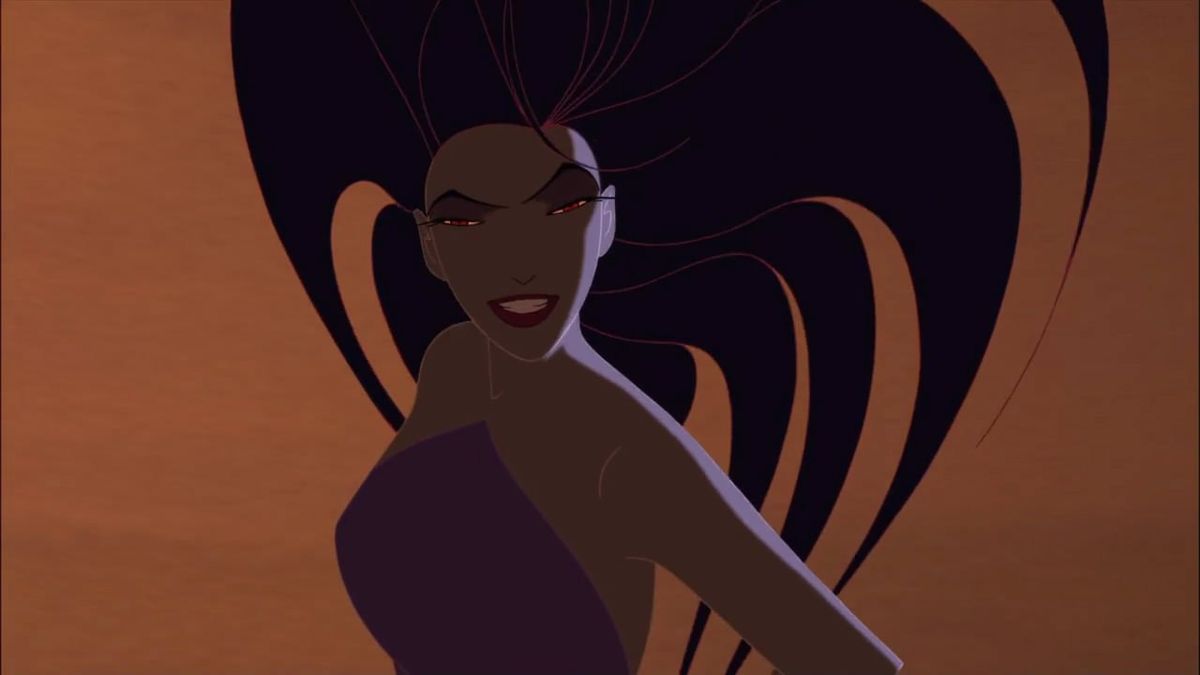
Image: DreamWorks
Release date: July 2, 2003
Director: Tim Johnson and Patrick Gilmore
Production budget: $60 million
Worldwide box office: $169.3 million
Rotten Tomatoes score: 45%
What it’s about
Sinbad is loosely inspired by the legend of Sinbad the Sailor, an Arabic mythological figure that first appeared in later editions of One Thousand and One Nights. In the movie, cocky pirate Sinbad (Brad Pitt) is framed by the goddess Eris (Michelle Pfeiffer) for stealing a priceless artifact. To save the life of his noble friend Prince Proteus (Joseph Fiennes), who offers to take Sinbad’s place in prison, Sinbad must journey to Eris’ realm at the end of the world. Determined to make sure Sinbad doesn’t just yeet off, Proteus’ fiancée, fearless ambassador Marina (Catherine Zeta-Jones), sneaks onto his ship. Along with Sinbad’s crew, they sail to the ends of the earth, encountering a handful of obstacles along the way.
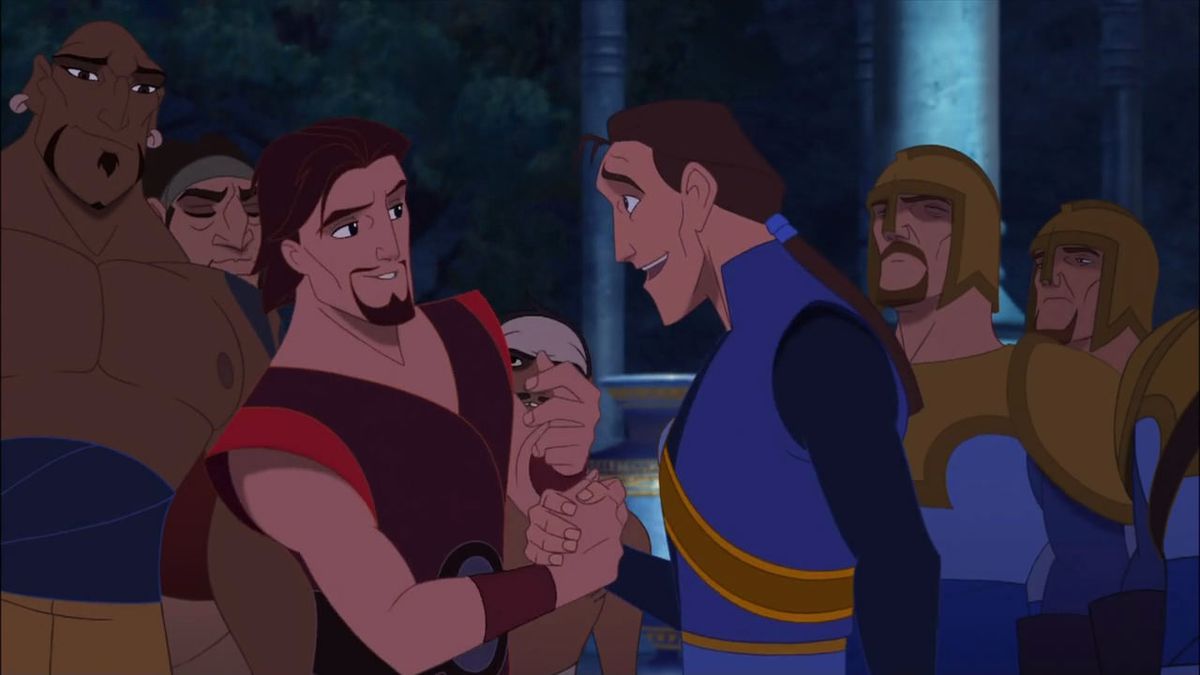
Image: DreamWorks
A little backstory…
A different Sinbad animated film actually started in development at Disney in 1992. After Aladdin’s success, screenwriters Ted Elliott and Terry Rossio pitched a version of the legend of Sinbad the Sailor. According to Rossio, that original version was a screwball romantic comedy featuring other staples from Arabian mythology, like Peri Banu, a genie-fairy who falls in love with a prince. (In that version, Sinbad was an apprentice mapmaker, and Peri a free-spirited smuggler.) That project never came into fruition at Disney, though the duo continued to explore the concept of folklore reshaped into classic comedic forms with The Road to El Dorado.
Rossio doesn’t know whether DreamWorks CEO Jeffrey Katzenberg was the common denominator between the Sinbad projects. He was at Disney when Rossio and Elliott initially pitched their version. But the project Katzenberg started up at DreamWorks in 2000 only really shared the character of Sinbad, with none of Rossio and Elliott’s romantic-comedy elements.
According to Rossio, he and Elliott boarded the DreamWorks project in December 2000, to help with the outlines and treatment. The new version of Sinbad was dramatically different from the screwball comedy they came up with in 1992 for Disney. It started as another one of their ideas — a story structured around the Damon and Pythias ideal of friendship. They pitched the idea to Katzenberg, who thought it would be perfect for a Sinbad film.
Katzenberg tapped Gladiator screenwriter John Logan for the script. Logan was an odd pick, having never worked on an animated feature before, but he had his own reasons for taking on the project.
“I have lots of young nieces and nephews, and finally they can see one of my movies,” Logan said in a 2003 interview with IGN. “It was like, ‘Okay, you can’t see Gladiator or Any Given Sunday; now, you can go see Sinbad!’”
Similarly, voice star Brad Pitt joined Sinbad in hopes of creating something for the kids in his extended family. “They can’t get into my movies,” he told Entertainment Weekly in 2003. ”People’s heads getting cut off, and all that.”
The Road to El Dorado’s legacy is strong
Rossio and Elliott’s first DreamWorks collaboration is the ultimate beloved failure
Read
But that focus on child audiences was a problem for Rossio and Elliott. Rossio tells Viaggio247 that they departed the project in April 2001. They had high hopes for the story, hoping to give it a bittersweet ending, and citing Casablanca as an inspiration for the movie’s ultimate romantic fallout. They wanted Sinbad to step away and let Proteus and Marina get together. But executives wanted a more conventionally happy ending, specifically with Marina and Sinbad sailing off together, kids in tow.
Rossio didn’t like this, because it undermined the emotional gravitas of the friendship between Sinbad and Proteus that was at the center of his original pitch. It also made Sinbad and Marina into generally unlikeable characters for basically cheating on Proteus, both in a romantic and friendship sense. So Rossio fired off a six-page memo to the team at DreamWorks, detailing exactly what was wrong with those choices. (In a blog post, he admits it was less because he thought he could convince the executives, and more to have a tangible “Told you so” after the fact). After that memo was received coolly, he fired off a follower, basically flat-out calling the story choices wrong.
“And that was the last of the consulting services we were asked to perform on the film,” Rossio writes.
Logan told IGN that the first draft he wrote was “very complex” and the relationships were “very adult” — too intense for the target audience. DreamWorks executives were aiming at a younger audience, which Rossio’s blog post implies changed during the film’s development. (“If you’re going to make a film marketed to kids,” he writes, “how about making that decision from the start?”)
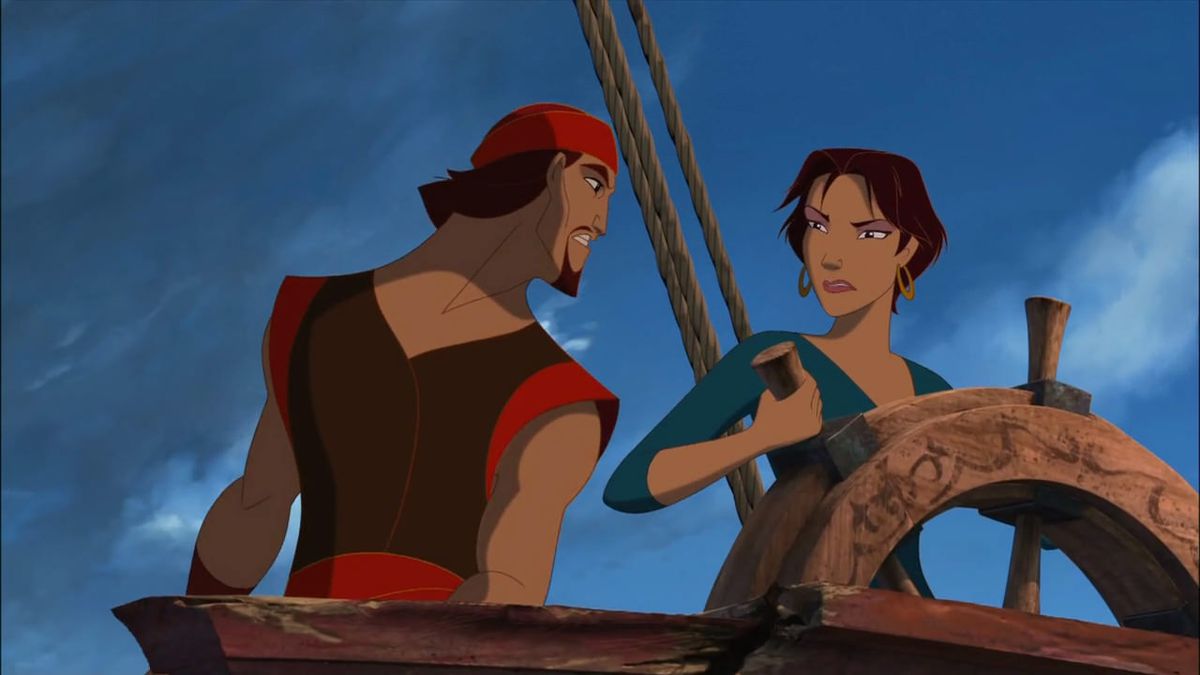
Image: DreamWorks
Why it didn’t work
As it turns out, the struggle between Rossio and Elliott’s original, more mature idea and the company’s kid-friendly plan ended up hamstringing the movie. At the time, DreamWorks’ films were noticeably more adult than Disney’s, from the crass humor in Antz and Shrek to the sweeping Biblical epic of The Prince of Egypt. All those projects were profitable successes, but executives who want to appeal to as many people as possible are still fixated on the notion that animation is solely a family-friendly endeavor.
And the tonal shifts throughout the film’s process left it inconsistent. Michelle Pfeiffer told EW that her character, Eris, was rewritten multiple times, with fixes to problems that just caused further problems. “First she was too sexual,” she says. ”Then we lost the fun. After the third time, I called Jeffrey Katzenberg and said, ‘You know, you really can fire me.’ He assured me it was just part of the process.” Critics later complained that the story fell flat because DreamWorks tried too hard to make the ancient epic appeal to kids. While some reviewers praised the comparatively adult storyline, the consensus was that it just didn’t work.
There was also the case of whitewashing. The original Sinbad comes from an Arab legend, but DreamWorks’ version is vaguely Sicilian, with elements of Greek and Roman mythology fused in, along with Brad Pitt’s Missourian accent. Logan told IGN he drew specifically from the Greco-Roman version of the story, which he felt drawn to.
“I was still so much in Gladiator mode that I was like, yes, Greek and Roman — this is a world I know! The Persian Sinbad, on the other hand, was just a little too much work for me,” he said.
Critic Jack Sheehan, however, told the Guardian that DreamWorks probably “feared financial and possibly political hardships if they made the film’s hero Arab,” especially in a post-9/11 America. Indeed, the original legend of Sinbad has the sailor specifically coming from Baghdad, which given the conflict in the Middle East at the time and the rampant Islamophobia in the United States, might have sparked unwanted discourse.
But perhaps this is a case of Occam’s Razor, and the simplest explanation will suffice. Sinbad: Legend of the Seven Seas came out a week before Pirates of the Caribbean: Curse of the Black Pearl. When it comes to seafaring adventures starring a young woman of noble birth who gets mixed up with a pirating scoundrel, even though her heart belongs to a more stalwart landlubber, Curse of the Black Pearl (tellingly, penned by Rossio and Elliott) is objectively the better movie. Anyone looking for a pirate movie would naturally pick Pirates of the Caribbean, while parents hesitant over the possible swashbuckling violence in Sinbad would take their kids to Finding Nemo, which premiered earlier that summer.
The movie’s middling performance didn’t offset the losses from DreamWorks’ other projects of that era, when the studio was producing a wave of traditionally animated clunkers and live-action flops. Meanwhile, Shrek, which grossed $484.4 million on a $60 million budget, seemed like a surefire sign to Katzenberg that audiences had come to favor CG animation over hand-drawn movies. Like so many other executives of the time, he was convinced audiences were drawn to the film’s medium, not its story, humor, or tone. And so DreamWorks’ traditional animation department was shuttered.
‘’I think the idea of a traditional story being told using traditional animation is likely a thing of the past,” Katzenberg told the New York Times.
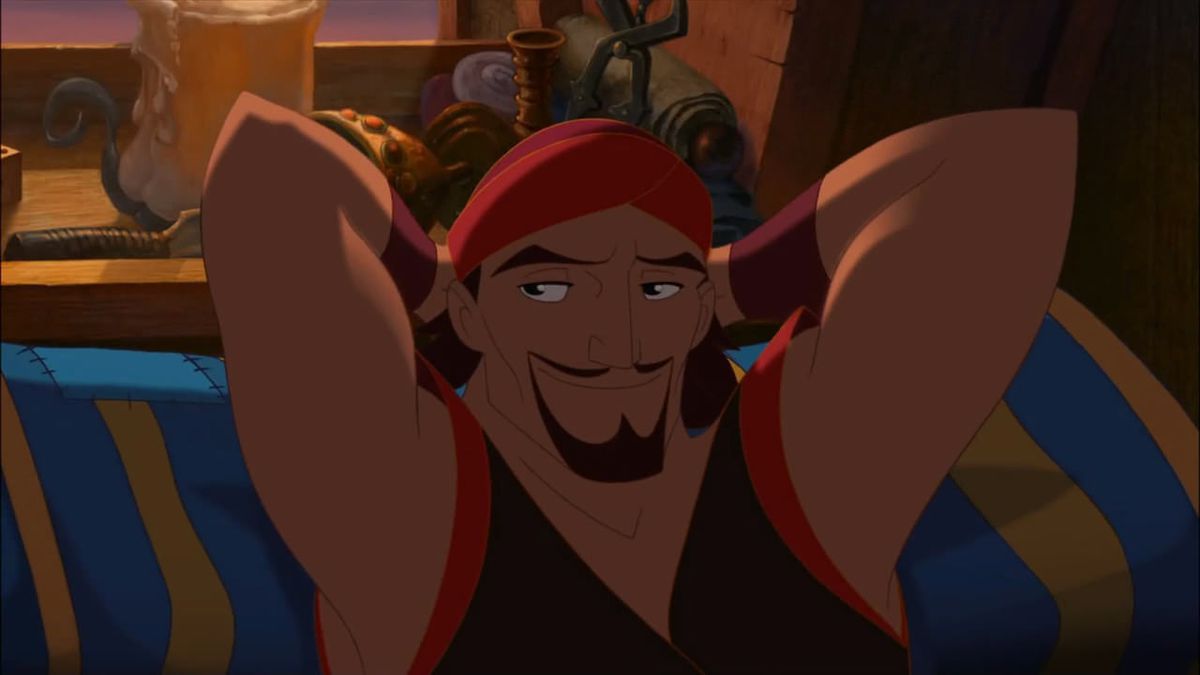
Image: DreamWorks
Why we love it today
To continue the Pirates of the Caribbean comparison, this is the movie for anyone who wanted Elizabeth to get together with Jack Sparrow.
Pirate movies were notoriously box-office poison in the decade prior, with 1995’s Cutthroat Island being the most prominent flop, so perhaps even without Pirates of the Caribbean’s swashbuckling success, Sinbad would’ve been doomed. But for kids who were just a tad too young for Curse of the Black Pearl’s skeletal pirate crew, Sinbad: Legend of the Seven Seas offered an alternative that seemed just as exciting at the time. It isn’t a straight-up parallel, given Sinbad’s nebulous setting, which has nothing to do with the Golden Age of piracy. But the mix of fantasy elements fused into a seafaring action-adventure is similar enough to make for a valid substitute.
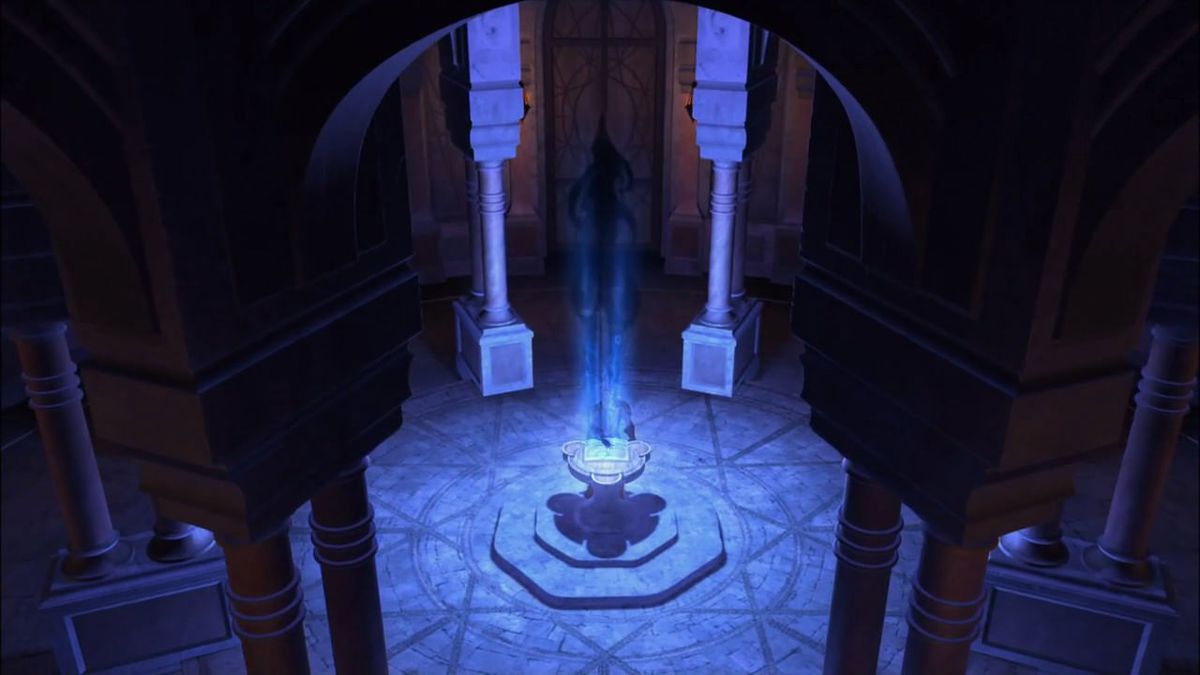
Image: DreamWorks
Sinbad and his crew run into various obstacles from myth, both directly from the Arabian Nights legend, and from a broader mythological canon. Sirens bewitch the crew, so Marina must take control of the ship. They end up on an island that turns out to be a sleeping magical fish. The sea freezes, and they run into a monstrous roc. Eris doesn’t really directly face them until the end, choosing instead to send these obstacles into their path. Even when they do meet her, it’s a different sort of conflict than a final fight — she challenges Sinbad to a game, which he loses, and then he sails home to take Proteus’ place in prison.
Eris is never actually defeated. They simply foil one specific plan of hers, and she sighs and retreats to her astral realm. But she’s a memorable part of the movie, a sultry, size-shifting goddess who pulls strings from behind the scenes and laughs at the machinations of mankind. Even when her scheme falls flat, her character design is electric.
It’s a pity that DreamWorks’ traditionally animated characters only got a few movies to shine, because the handful of films the studio did make carved out a distinct character design, with especially expressive faces. The female characters in particular ended up with a wide range of facial shapes — surpassing Disney’s much-maligned standard heart-shaped face/button-nose formula for its heroines. The design choices are carried out in DreamWorks’ CG work, but the company’s short-lived venture into traditional animation just speaks to what could have been. Sinbad, the last of DreamWorks’ 2D animated movies, has a whole pirate crew full of expressively animated characters.
Much as Disney’s Treasure Planet marked a true hybrid between CG and traditional hand-drawn animation for Disney, Sinbad was DreamWorks’ venture into this look. But because Sinbad wasn’t a science-fiction movie, the CG risked looking out of place. The computer-animated water, in fact, looked too realistic. The team had to modify it to more cohesively fit the look of the movie, by developing a new technique for the ripple distortion, as well as integrating hand-drawn splashes into it. The overall result still has some jarring moments — the sea monsters in the beginning of the movie, for instance, don’t have the narrative excuse of being beings of pure energy like Titan A.E.’s CG creatures — but when it comes to the landscapes, the movie is stunning.
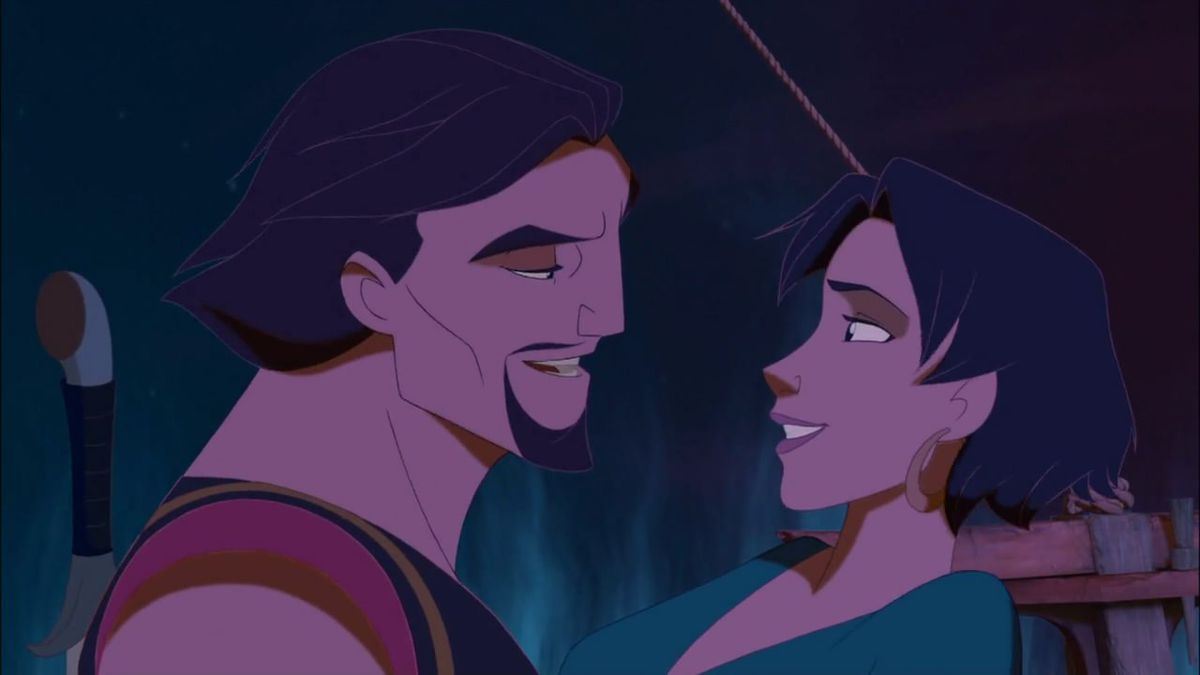
Image: DreamWorks
Even if the the movie’s love triangle didn’t wrap up with the emotional gravitas Rossio and Elliott envisioned, it’s still an interesting and complex relationship. It’s a hodgepodge of fun, satisfying tropes: enemies-to-lovers, the honor-bound engagement, the childhood friends forced onto opposite sides of the law. Sure, maybe the movie could’ve used more scenes of Proteus and Sinbad as kids to establish that relationship, and sure, it does lose some of its dramatic weight if Sinbad and Marina end up together and Proteus is totally okay with that. Nevertheless, it’s still an exciting and more complex dynamic than the simple girl-meets-boy-and-falls-in-love that so many princess movies are built upon. Marina puts Sinbad in his place, and they eventually build up a mutual respect. By the time the two dive into Eris’ realm together, their chemistry sizzles.
Sinbad: Legend of the Seven Seas ended DreamWorks’ brief foray into traditional animation — not because it was particularly bad, but because it could’ve been so much more. In the end, it suffered from a combination of confused expectations and debuting at a bad time, and it eventually just drifted off into the land of home entertainment. But buried deep in the backstory is a gem of a movie, a proper swashbuckling adventure with complexity at its core, which sparked to those who found it after the fact and recognized its lost potential.
Sinbad: Legend of the Seven Seas is available to stream on Hulu.
